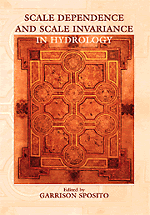Book contents
- Frontmatter
- Contents
- List of Contributors
- Preface
- 1 Scale Analyses for Land-Surface Hydrology
- 2 Hillslopes, Channels, and Landscape Scale
- 3 Scaling in River Networks
- 4 Spatial Variability and Scale Invariance in Hydrologic Regionalization
- 5 An Emerging Technology for Scaling Field Soil-Water Behavior
- 6 Scaling Invariance and the Richards Equation
- 7 Scaling of the Richards Equation and Its Application to Watershed Modeling
- 8 Scale Issues of Heterogeneity in Vadose-Zone Hydrology
- 9 Stochastic Modeling of Scale-dependent Macrodispersion in the Vadose Zone
- 10 Dilution of Nonreactive Solutes in Heterogeneous Porous Media
- 11 Analysis of Scale Effects in Large-Scale Solute-Transport Models
- 12 Scale Effects in Fluid Flow through Fractured Geologic Media
- 13 Correlation, Flow, and Transport in Multiscale Permeability Fields
- 14 Conditional Simulation of Geologic Media with Evolving Scales of Heterogeneity
- Index
5 - An Emerging Technology for Scaling Field Soil-Water Behavior
Published online by Cambridge University Press: 18 January 2010
- Frontmatter
- Contents
- List of Contributors
- Preface
- 1 Scale Analyses for Land-Surface Hydrology
- 2 Hillslopes, Channels, and Landscape Scale
- 3 Scaling in River Networks
- 4 Spatial Variability and Scale Invariance in Hydrologic Regionalization
- 5 An Emerging Technology for Scaling Field Soil-Water Behavior
- 6 Scaling Invariance and the Richards Equation
- 7 Scaling of the Richards Equation and Its Application to Watershed Modeling
- 8 Scale Issues of Heterogeneity in Vadose-Zone Hydrology
- 9 Stochastic Modeling of Scale-dependent Macrodispersion in the Vadose Zone
- 10 Dilution of Nonreactive Solutes in Heterogeneous Porous Media
- 11 Analysis of Scale Effects in Large-Scale Solute-Transport Models
- 12 Scale Effects in Fluid Flow through Fractured Geologic Media
- 13 Correlation, Flow, and Transport in Multiscale Permeability Fields
- 14 Conditional Simulation of Geologic Media with Evolving Scales of Heterogeneity
- Index
Summary
Introduction
In 1955, Miller and Miller created a new avenue for research in soil hydrology when they presented their pioneering concepts for scaling capillary-flow phenomena. Their description of the self-similar microscopic soil-particle structure and its implications for the retention and transport of soil water stimulated many studies to test how well laboratory-measured soil-water retention curves could be coalesced into a single-scale mean function (e.g., Klute and Wilkinson, 1958). Because the results from ensuing tests were not particularly encouraging, except for soils composed of graded sands, their scaling concepts lay idle for several years. At that time, when the pressure-outflow method (Gardner, 1956) and other transient methods for estimating the value of the hydraulic conductivity in the laboratory were still in their infancy, few attempts were being made to scale the hydraulic-conductivity function, owing to the paucity of data from its quantitative observation. It was during that same period that the classic works of Philip (1955, 1957), describing a solution for the Richards equation, shifted attention to infiltration. With field measurements of soil-water properties only beginning to be reported (e.g., Richards, Gardner, and Ogata, 1956), little information was available on the reliability of their measurements or on the variations in their magnitudes to be expected within a particular field or soil mapping unit.
During the 1960s, the development and acceptance of the portable neutron meter to measure soil-water content spurred research into field-measured soil-water properties. Because of its availability, combined with the well-known technology of tensiometry, field studies of soil-water behavior accelerated in the 1970s.
- Type
- Chapter
- Information
- Scale Dependence and Scale Invariance in Hydrology , pp. 136 - 166Publisher: Cambridge University PressPrint publication year: 1998
- 14
- Cited by



